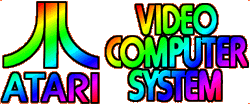|

VCS
Asteroids programmed by Brad Stewart was released in Britain
in October 1981 (after a July US release) and cost a whopping
£34.50. The programming code for Asteroids became the biggest
so far by using 6000 bytes (everybody go wooh!). Although graphically
dissimilar from the arcade version, it was a great game in its
own right and its sales made it one of the big three.

One point that I always found a little strange is all the early
VCS carts never said "game over" like I was used to in the arcades.
They just kind of stopped and the colour palette changed every
five seconds. This was actually a routine to prevent screen burn which had been a problem with Pong consoles.
Also in October '81 the first Activision cartridges to
reach our shores were on sale. Tennis and Boxing
cost just £16.95. At first the effect was a positive one for Atari.
These extra games made the console seem even more attractive.
In March 1982 the Economist stated that Atari's 75% share
of the software market could mean $400 million in pre tax profits.
Obviously this was attractive to other companies.
First
Activision then Imagic started to release compatible games.
They were soon joined by Parker Bros, Apollo, Bomb, Coleco,
M-Network, Spectravision, Telesys and Tigervision.
By December 1982 Geoffrey Wheeler editorial director of Game Merchandising
magazine announced there were 400 game cartridges on the market.
This
is how Atari's problems started. In part two RETROGAMER sees Atari
release the VCS version of the biggest coin-op in history, Pac-man,
then a year later they lose $310 million a single four month period.
Part Two can be found in issue four of RETROGAMER fanzine
which is available for £1.50 from:
Keith
Ainsworth at 52 Kingfield Road, Orrell Park, Liverpool, L9 3AW,
United Kingdom.
I
have Atari VCS consoles and loads of carts
for sale or trade listed here.
This document is copyright 1996-2001 Keith Ainsworth and can be found
at http://retrogamer.merseyworld.com/
|

